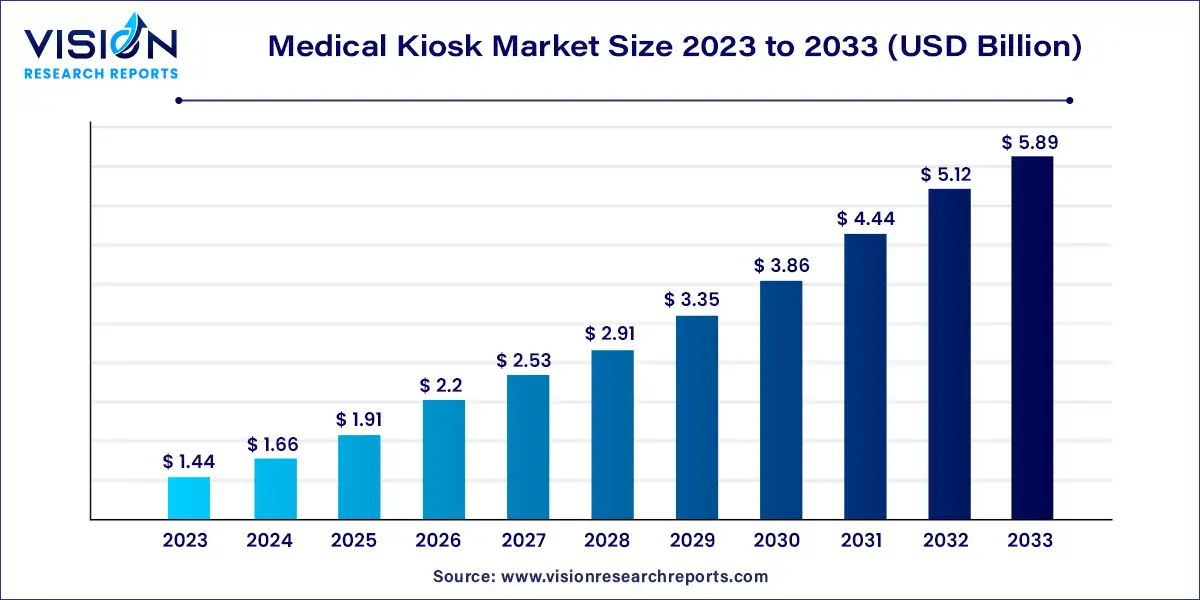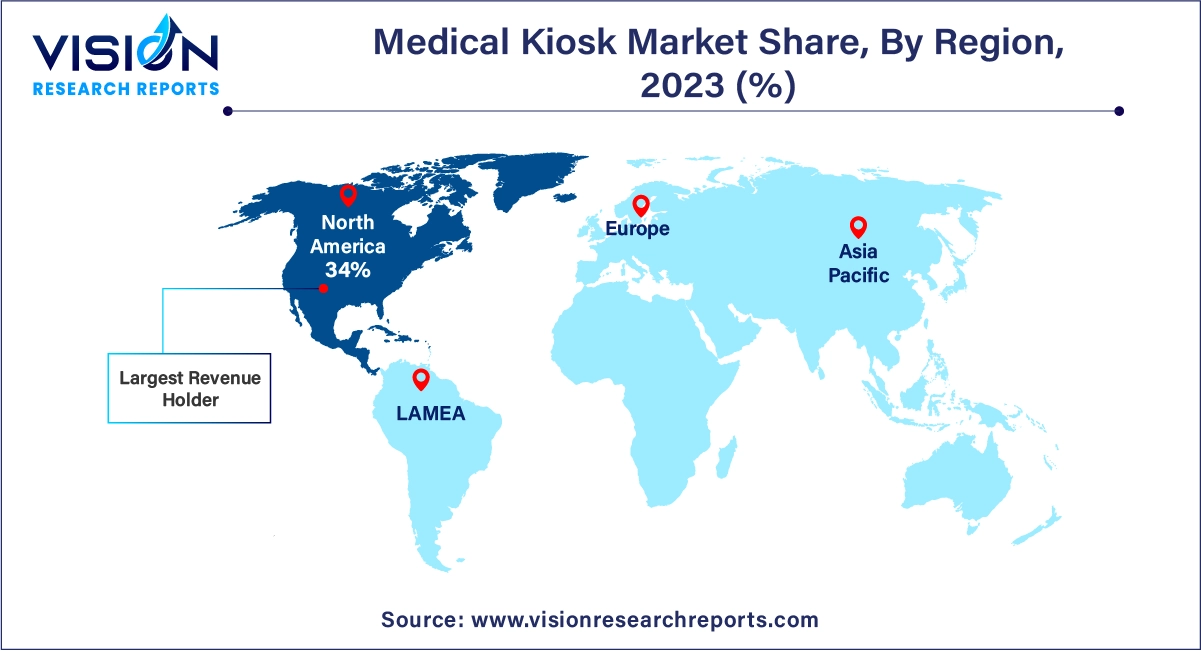The global medical kiosk market size was estimated at around USD 1.44 billion in 2023 and it is projected to hit around USD 5.89 billion by 2033, growing at a CAGR of 15.13% from 2024 to 2033. The medical kiosk market has been evolving rapidly, driven by advancements in healthcare technology and the increasing need for efficient patient management solutions. Medical kiosks are self-service terminals used in various healthcare settings, including hospitals, clinics, and pharmacies. They offer a range of functionalities such as patient check-in, appointment scheduling, and health information dissemination, streamlining administrative processes and enhancing patient experience.
The growth of the medical kiosk market is significantly influenced by an increasing emphasis on healthcare efficiency and patient convenience drives the demand for automated solutions. Medical kiosks streamline administrative tasks, reduce wait times, and enhance overall operational efficiency, aligning with the broader trend towards digital transformation in healthcare. Additionally, advancements in technology, such as the integration of artificial intelligence and biometric systems, have expanded the capabilities of medical kiosks, making them more versatile and user-friendly. The growing focus on patient-centric care also contributes to market growth, as medical kiosks offer patients an accessible way to manage their healthcare interactions independently. Furthermore, the rising adoption of electronic health records (EHR) systems and the need for seamless data management support the integration of kiosks into healthcare facilities, fostering their widespread implementation and growth.
North America dominated the market with a 55% share in 2023. This is due to the presence of major industry players, technological advancements, and a high demand for digital health solutions. The 2020 Kiosk Marketplace Census Report indicates that over 50% of check-in kiosk manufacturers are based in the U.S., positioning North America as a key hub for technology-driven business models and innovations.
| Attribute | North America |
| Market Value | USD 0.79 Billion |
| Growth Rate | 15.14% CAGR |
| Projected Value | USD 3.23 Billion |
In Europe, the medical kiosk market is also growing, driven by a demand for self-service options similar to trends in the U.S. The aging population is putting pressure on healthcare systems, and kiosks help automate tasks and improve patient flow. Government initiatives promoting digital health are further boosting market growth.

Asia Pacific is expected to see substantial growth in the medical kiosk market, supported by an increase in digital health businesses and significant government investments in IT infrastructure.
In 2023, the self-service kiosk segment led the market with a substantial revenue share of 28%. This dominance is attributed to the rising demand for online and instant services, fueled by the widespread adoption of touch screen technology across various sectors. Additionally, the growing patient population, particularly those needing primary care and managing chronic conditions, drives the need for streamlined check-in processes, online appointment scheduling, and convenient payment solutions. Self-service kiosks help alleviate the workload on healthcare professionals and shift some of the patient management responsibilities to the patients themselves.
The telemedicine kiosk segment is expected to experience the highest growth rate during the forecast period. Telemedicine kiosks are poised to become a vital component of healthcare systems, enabling remote patient consultations through communication technologies. They offer potential cost savings on patient care, hospital stays, and reduce waiting times. The increasing prevalence of chronic diseases necessitates frequent check-ups and follow-ups, making telemedicine kiosks a convenient solution for these routine interactions, thus enhancing patient care management and minimizing unnecessary hospital admissions.
In 2023, hospitals were the leading segment in the market, driven by high patient volumes and the need to optimize workflows and reduce waiting times. The sector's growth is further supported by hospitals' increased investments in digital health technologies. Hospital administrators recognize that improving patient satisfaction is crucial, and kiosks help streamline processes such as check-ins, appointment scheduling, and billing, reducing delays and frustration. The focus on enhancing patient care and operational efficiency is expected to propel market growth.
The "Other" segment is projected to grow at the fastest rate during the forecast period. This category includes specialized clinics such as cancer centers and sexual health clinics, which handle referrals from primary care and outpatient departments. These clinics benefit from self-service kiosks that allow for convenient appointment scheduling and minimize potentially uncomfortable interactions with reception staff. Additionally, kiosks provide educational materials and appointment reminders, empowering patients to actively manage their health.
By Type
By Facility
By Region
Chapter 1. Introduction
1.1. Research Objective
1.2. Scope of the Study
1.3. Definition
Chapter 2. Research Methodology
2.1. Research Approach
2.2. Data Sources
2.3. Assumptions & Limitations
Chapter 3. Executive Summary
3.1. Market Snapshot
Chapter 4. Market Variables and Scope
4.1. Introduction
4.2. Market Classification and Scope
4.3. Industry Value Chain Analysis
4.3.1. Raw Material Procurement Analysis
4.3.2. Sales and Distribution Channel Analysis
4.3.3. Downstream Buyer Analysis
Chapter 5. COVID 19 Impact on Medical Kiosk Market
5.1. COVID-19 Landscape: Medical Kiosk Industry Impact
5.2. COVID 19 - Impact Assessment for the Industry
5.3. COVID 19 Impact: Global Major Government Policy
5.4. Market Trends and Opportunities in the COVID-19 Landscape
Chapter 6. Market Dynamics Analysis and Trends
6.1. Market Dynamics
6.1.1. Market Drivers
6.1.2. Market Restraints
6.1.3. Market Opportunities
6.2. Porter’s Five Forces Analysis
6.2.1. Bargaining power of suppliers
6.2.2. Bargaining power of buyers
6.2.3. Threat of substitute
6.2.4. Threat of new entrants
6.2.5. Degree of competition
Chapter 7. Competitive Landscape
7.1.1. Company Market Share/Positioning Analysis
7.1.2. Key Strategies Adopted by Players
7.1.3. Vendor Landscape
7.1.3.1. List of Suppliers
7.1.3.2. List of Buyers
Chapter 8. Global Medical Kiosk Market, By Type
8.1. Medical Kiosk Market, by Type, 2024-2033
8.1.1. Check-In-Kiosk
8.1.1.1. Market Revenue and Forecast (2021-2033)
8.1.2. Payment Kiosk
8.1.2.1. Market Revenue and Forecast (2021-2033)
8.1.3. Way Finding Kiosk
8.1.3.1. Market Revenue and Forecast (2021-2033)
8.1.4. Telemedicine Kiosk
8.1.4.1. Market Revenue and Forecast (2021-2033)
8.1.5. Self-service Kiosk
8.1.5.1. Market Revenue and Forecast (2021-2033)
Chapter 9. Global Medical Kiosk Market, By Facility
9.1. Medical Kiosk Market, by Facility, 2024-2033
9.1.1. Specialty Clinics
9.1.1.1. Market Revenue and Forecast (2021-2033)
9.1.2. Hospitals
9.1.2.1. Market Revenue and Forecast (2021-2033)
9.1.3. Pharmacies
9.1.3.1. Market Revenue and Forecast (2021-2033)
9.1.4. Others
9.1.4.1. Market Revenue and Forecast (2021-2033)
Chapter 10. Global Medical Kiosk Market, Regional Estimates and Trend Forecast
10.1. North America
10.1.1. Market Revenue and Forecast, by Type (2021-2033)
10.1.2. Market Revenue and Forecast, by Facility (2021-2033)
10.1.3. U.S.
10.1.3.1. Market Revenue and Forecast, by Type (2021-2033)
10.1.3.2. Market Revenue and Forecast, by Facility (2021-2033)
10.1.4. Rest of North America
10.1.4.1. Market Revenue and Forecast, by Type (2021-2033)
10.1.4.2. Market Revenue and Forecast, by Facility (2021-2033)
10.2. Europe
10.2.1. Market Revenue and Forecast, by Type (2021-2033)
10.2.2. Market Revenue and Forecast, by Facility (2021-2033)
10.2.3. UK
10.2.3.1. Market Revenue and Forecast, by Type (2021-2033)
10.2.3.2. Market Revenue and Forecast, by Facility (2021-2033)
10.2.4. Germany
10.2.4.1. Market Revenue and Forecast, by Type (2021-2033)
10.2.4.2. Market Revenue and Forecast, by Facility (2021-2033)
10.2.5. France
10.2.5.1. Market Revenue and Forecast, by Type (2021-2033)
10.2.5.2. Market Revenue and Forecast, by Facility (2021-2033)
10.2.6. Rest of Europe
10.2.6.1. Market Revenue and Forecast, by Type (2021-2033)
10.2.6.2. Market Revenue and Forecast, by Facility (2021-2033)
10.3. APAC
10.3.1. Market Revenue and Forecast, by Type (2021-2033)
10.3.2. Market Revenue and Forecast, by Facility (2021-2033)
10.3.3. India
10.3.3.1. Market Revenue and Forecast, by Type (2021-2033)
10.3.3.2. Market Revenue and Forecast, by Facility (2021-2033)
10.3.4. China
10.3.4.1. Market Revenue and Forecast, by Type (2021-2033)
10.3.4.2. Market Revenue and Forecast, by Facility (2021-2033)
10.3.5. Japan
10.3.5.1. Market Revenue and Forecast, by Type (2021-2033)
10.3.5.2. Market Revenue and Forecast, by Facility (2021-2033)
10.3.6. Rest of APAC
10.3.6.1. Market Revenue and Forecast, by Type (2021-2033)
10.3.6.2. Market Revenue and Forecast, by Facility (2021-2033)
10.4. MEA
10.4.1. Market Revenue and Forecast, by Type (2021-2033)
10.4.2. Market Revenue and Forecast, by Facility (2021-2033)
10.4.3. GCC
10.4.3.1. Market Revenue and Forecast, by Type (2021-2033)
10.4.3.2. Market Revenue and Forecast, by Facility (2021-2033)
10.4.4. North Africa
10.4.4.1. Market Revenue and Forecast, by Type (2021-2033)
10.4.4.2. Market Revenue and Forecast, by Facility (2021-2033)
10.4.5. South Africa
10.4.5.1. Market Revenue and Forecast, by Type (2021-2033)
10.4.5.2. Market Revenue and Forecast, by Facility (2021-2033)
10.4.6. Rest of MEA
10.4.6.1. Market Revenue and Forecast, by Type (2021-2033)
10.4.6.2. Market Revenue and Forecast, by Facility (2021-2033)
10.5. Latin America
10.5.1. Market Revenue and Forecast, by Type (2021-2033)
10.5.2. Market Revenue and Forecast, by Facility (2021-2033)
10.5.3. Brazil
10.5.3.1. Market Revenue and Forecast, by Type (2021-2033)
10.5.3.2. Market Revenue and Forecast, by Facility (2021-2033)
10.5.4. Rest of LATAM
10.5.4.1. Market Revenue and Forecast, by Type (2021-2033)
10.5.4.2. Market Revenue and Forecast, by Facility (2021-2033)
Chapter 11. Company Profiles
11.1. Olea Kiosks Inc.
11.1.1. Company Overview
11.1.2. Product Offerings
11.1.3. Financial Performance
11.1.4. Recent Initiatives
11.2. Fabcon, Inc.
11.2.1. Company Overview
11.2.2. Product Offerings
11.2.3. Financial Performance
11.2.4. Recent Initiatives
11.3. Meridian Kiosks
11.3.1. Company Overview
11.3.2. Product Offerings
11.3.3. Financial Performance
11.3.4. Recent Initiatives
11.4. XIPHIAS Software Technologies
11.4.1. Company Overview
11.4.2. Product Offerings
11.4.3. Financial Performance
11.4.4. LTE Scientific
11.5. RedyRef Interactive Kiosks
11.5.1. Company Overview
11.5.2. Product Offerings
11.5.3. Financial Performance
11.5.4. Recent Initiatives
11.6. imageHOLDERS
11.6.1. Company Overview
11.6.2. Product Offerings
11.6.3. Financial Performance
11.6.4. Recent Initiatives
11.7. KIOSK Information Systems
11.7.1. Company Overview
11.7.2. Product Offerings
11.7.3. Financial Performance
11.7.4. Recent Initiatives
11.8. Frank Mayer and Associates, Inc.
11.8.1. Company Overview
11.8.2. Product Offerings
11.8.3. Financial Performance
11.8.4. Recent Initiatives
11.9. Kiosks4business Ltd.
11.9.1. Company Overview
11.9.2. Product Offerings
11.9.3. Financial Performance
11.9.4. Recent Initiatives
11.10. DynaTouch Corporation
11.10.1. Company Overview
11.10.2. Product Offerings
11.10.3. Financial Performance
11.10.4. Recent Initiatives
Chapter 12. Research Methodology
12.1. Primary Research
12.2. Secondary Research
12.3. Assumptions
Chapter 13. Appendix
13.1. About Us
13.2. Glossary of Terms
 Cross-segment Market Size and Analysis for
Mentioned Segments
Cross-segment Market Size and Analysis for
Mentioned Segments
 Additional Company Profiles (Upto 5 With No Cost)
Additional Company Profiles (Upto 5 With No Cost)
 Additional Countries (Apart From Mentioned Countries)
Additional Countries (Apart From Mentioned Countries)
 Country/Region-specific Report
Country/Region-specific Report
 Go To Market Strategy
Go To Market Strategy
 Region Specific Market Dynamics
Region Specific Market Dynamics Region Level Market Share
Region Level Market Share Import Export Analysis
Import Export Analysis Production Analysis
Production Analysis Others
Others